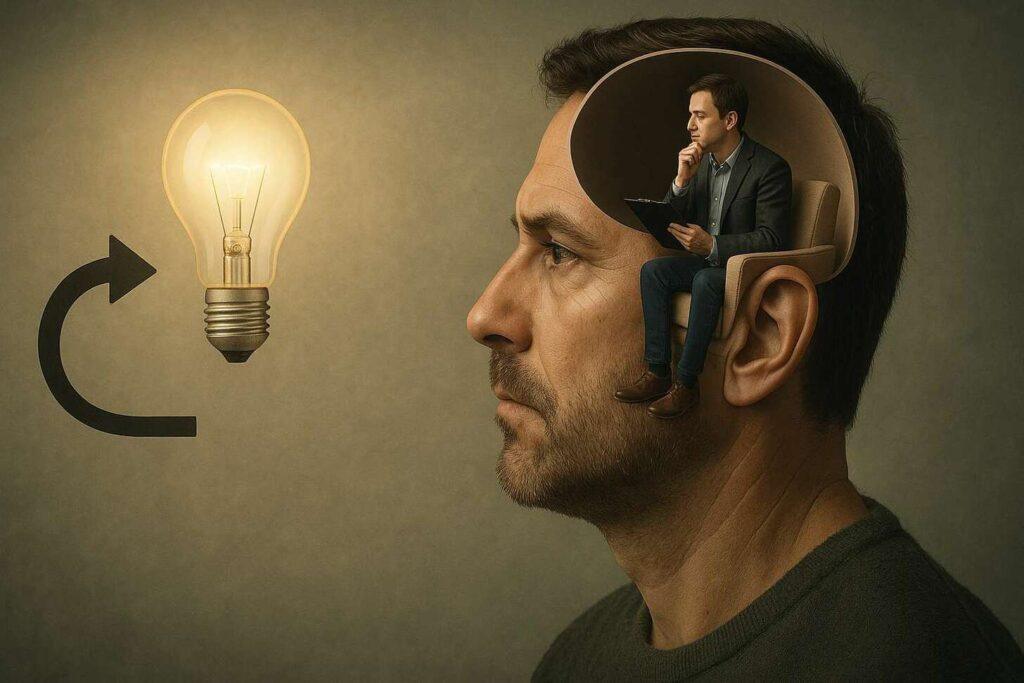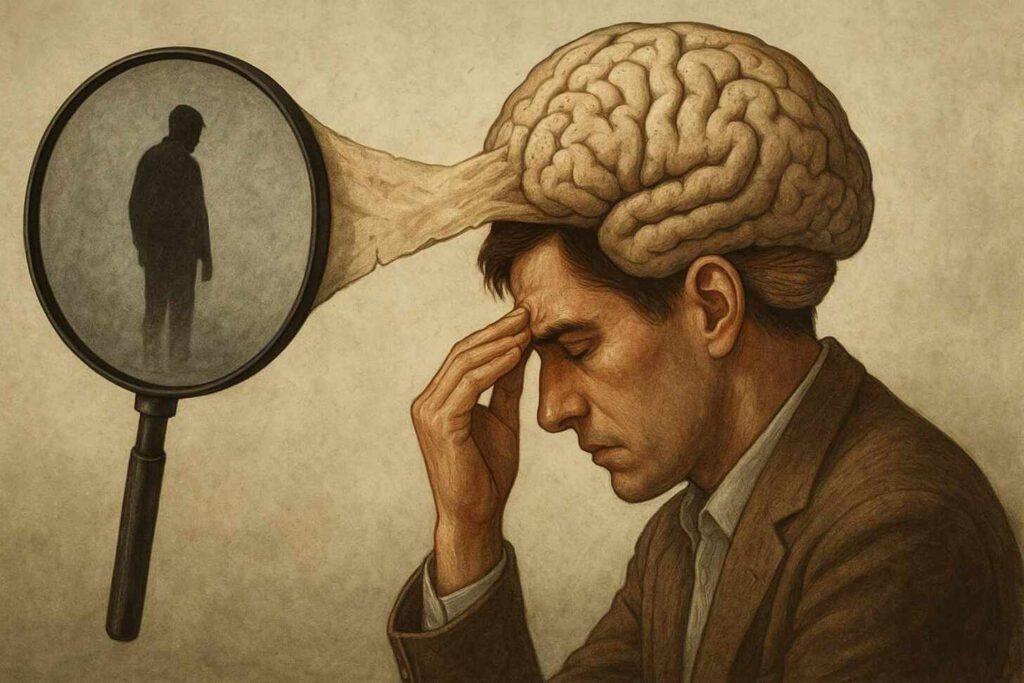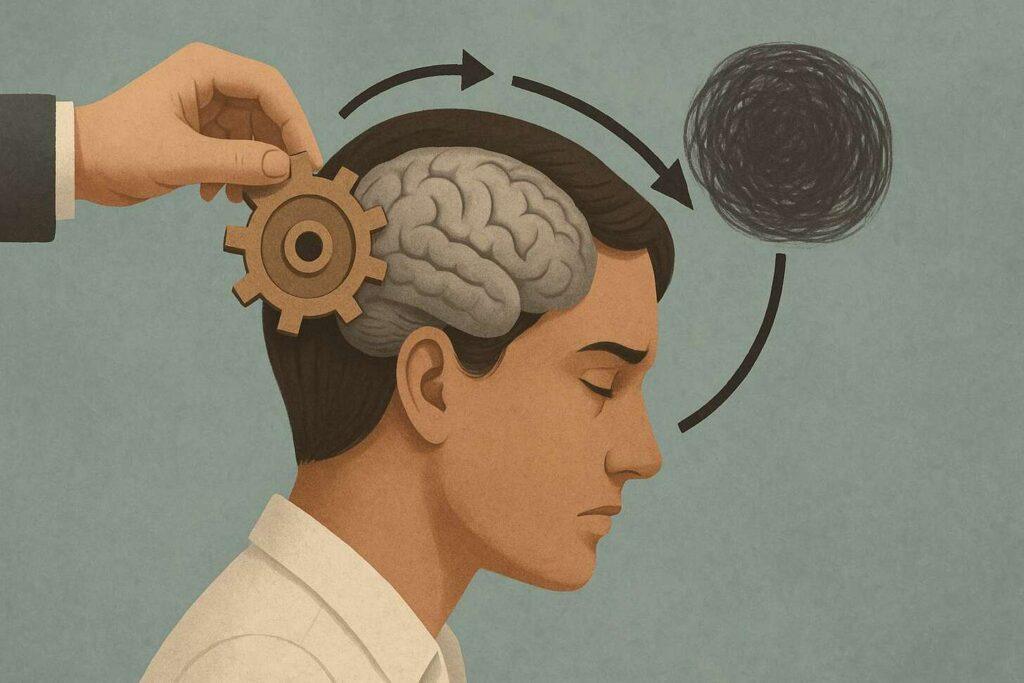In the 19th century, British economist William Stanley Jevons made a key discovery. He found that as coal-burning engines got more efficient, people used more coal. This finding, known as the Rebound Effect mental model, reveals a surprising truth.
Improvements in efficiency can actually lead to more use, not less. For example, better fuel economy might make people drive more. Energy-saving bulbs could also mean lights stay on longer.
It reveals how progress in one area often creates unintended consequences in another, such as the effects thought suppression can have on our productivity. Like a stretched rubber band snapping back, efficiency gains can lead to overuse, erasing the benefits we expect.
This pattern appears everywhere. Fuel-efficient cars lower gas costs—but drivers might take longer trips. Productivity tools save hours—yet we fill that time with more tasks. Even in psychology, suppressing difficult thoughts often makes them resurface stronger. Research on trauma recovery shows similar trends, where attempts to control emotions after accidents can deepen their grip.
Why does this matter? Recognizing these hidden traps helps us make smarter choices. Instead of chasing endless upgrades, we learn to pair improvements with intentional boundaries. This awareness turns frustration into strategy—whether managing habits, finances, or personal growth.
Key Takeaways
- Rebound effect mental model: Efficiency gains often lead to increased usage, canceling out expected benefits
- Modern tools like apps or eco-friendly tech frequently trigger this pattern
- Psychological studies link thought suppression to stronger emotional rebounds
- Small daily choices contribute to larger cycles of overconsumption
- Awareness helps create guardrails against self-defeating habits
By understanding the rebound effect mental model, we stop blaming ourselves when progress backfires. Instead, we design systems that account for human nature—combining better tools with wiser usage.
Overview of the Rebound Effect Mental Model
Ever notice how strict diets often lead to late-night snack binges? This paradox lies at the heart of a powerful pattern shaping our decisions. When we improve efficiency—whether in technology or daily habits—we often trigger counterproductive behaviors, such as intrusive thoughts, that erase gains.
This is similar to the concept of thought suppression, where trying to control our cravings can ironically lead to greater challenges in mental health.
Definition and Core Concepts
At its core, this phenomenon works like squeezing a balloon. Make one area tighter (time, money, energy), and pressure shifts elsewhere. Fuel-saving cars enable longer drives. Productivity apps invite more tasks. Our brains treat saved resources as invitations to expand—not reduce—consumption.
Psychologists discovered similar patterns in thought suppression. Trying to block unwanted ideas often amplifies them. A 1987 study asked participants to avoid thinking about white bears. Guess what dominated their minds? This ironic process theory shows how forceful control backfires.
Historical and Theoretical Background
Two fields converged to explain these trade-offs. Economists in the 1980s tracked how energy-efficient appliances increased household electricity use. Meanwhile, cognitive researchers explored why avoiding certain thoughts made them stickier.
Both groups reached the same conclusion: suppression creates tension. Whether managing resources or emotions, strict limits often fuel what they try to contain. This dual perspective helps us design better systems—ones that work with human nature rather than against it.
When Energy Efficiency Backfires

Why do energy-efficient upgrades sometimes leave your bills unchanged? A curious pattern emerges when we track how people actually use improved systems.
What looks like progress on paper often gets reshaped by everyday choices, much like how intrusive thoughts can reshape our mental landscape, leading to thought suppression and affecting our decisions.
Fuel-Efficient Vehicles and Increased Driving
Imagine buying a hybrid car to save money—then taking three extra weekend trips a month. This isn’t hypothetical. A 2016 U.S. Energy Information Administration study found drivers of fuel-efficient vehicles logged 10-12% more miles. The result? Expected fuel savings dropped by nearly 30%.
It’s like getting a raise and immediately upgrading your apartment. The budget resets, but the savings vanish. This behavioral shift explains why purely technical solutions often underdeliver.
Real-World Savings and Consumption Patterns
Lighting upgrades show similar trends. When UK households switched to LEDs, their light usage jumped 5%. Lower hourly costs created permission to leave lamps on longer—a measurable effect seen across energy systems.
Your thermostat tells the same story. Programmable models can reduce heating bills—unless you override settings for extra comfort. Energy economics research confirms this cycle: every efficiency gain carries hidden invitations to consume more.
These findings challenge simple fixes. Lasting change requires pairing better tools with mindful habits. After all, what good is a fuel-sipping engine if we keep expanding how far we roam?
The Rebound Effect in Technology and Automation

Automation promised freedom—so why are we clocking more hours than ever? The same systems designed to simplify work often reshape expectations, leading to a form of thought suppression regarding our time.
What begins as a time-saving tool becomes a productivity trap, quietly rewriting the rules of “enough” and affecting how we manage our thoughts and information.
Explaining the Productivity Paradox
Consider email management tools. They help you respond faster—but also encourage 20% more messages daily. A 2021 Harvard study found 43% of companies saw zero stress reduction after adopting efficiency tech. Why? Saved minutes get converted into extra tasks.
This isn’t flawed software. It’s human nature. When you finish reports 30% quicker, clients assume capacity for three more projects. Bosses see empty calendar slots as invitations, not achievements. The system works perfectly—just not for individuals seeking balance.
Automation and Rising Workload Expectations
Project management platforms illustrate this shift. Teams complete tasks faster, but leaders simply add phases to timelines. One marketing agency reported a 15% workload increase after automating social media posts—”Now we handle eight platforms instead of four.”
The solution? Pair strategies with processes. Set clear boundaries before implementing new tools. Example: “We’ll use this app to protect two lunch hours weekly.” Without intentional guardrails, efficiency becomes its own form of suppression—silently compressing your margins for rest.
Behavioral Psychology and the Rebound Effect

Behavioral psychology sheds light on why the rebound effect mental model is common today. Our habits and automatic actions change based on perceived gains. For instance, if something becomes easier or faster, we use it more without thinking.
This pattern fits with both classical and behavioral economics. It shows how utility isn’t just about what happens, but also what we expect and how things are presented.
Knowing this human tendency helps us understand why making daily tasks easier doesn’t always work as expected. It’s not just about the tools we use. It’s how we react to having more of something.
This view changes how we see the rebound effect. Instead of a system failure, it’s a natural result of how we’re designed to behave.
Cognitive Biases That Fuel the Rebound
Several cognitive biases are behind the rebound effect mental model. The most notable ones are:
- Availability Heuristic: When tools make tasks easier, people remember how simple it was before. They then use it too much.
- Hyperbolic Discounting: People prefer quick fixes, like checking a notification, over long-term goals like getting rest.
- Optimism Bias: Users think they’ll use saved time well, but new tasks quickly fill it up.
Understanding these biases shows the rebound effect mental model isn’t just a mistake. It’s how our brains make quick decisions. Without limits or breaks, these habits are hard to change.
How Efficiency Changes Behavior

Ever finish a Netflix series faster because you skipped intros—only to start another episode immediately? Time-saving features often reshape our habits in unexpected ways. When systems become more efficient, our brains instinctively seek to fill the saved space, leading to a rebound effect similar to thought suppression.
Like water expanding to fill a container, we adapt without realizing it, often pushing away unwanted thoughts and memories, which can have deeper effects on our mental health, including links to depression.
Shifts in Consumer Behavior Following Efficiency Gains
Research reveals a curious pattern: people consume 18-22% more of a resource when accessing it becomes easier. Faster internet leads to longer browsing. Meal prep apps result in more complex recipes. Our brains treat saved time as extra capacity rather than a windfall to preserve.
| Efficiency Gain | Initial Benefit | Behavioral Shift | Net Outcome |
|---|---|---|---|
| Streaming buffering reduced | Less waiting time | Longer viewing sessions | +25% data usage |
| Grocery delivery apps | Time saved shopping | More impulse purchases | +14% spending |
| Quick email templates | Faster responses | Higher message volume | No time saved |
This mirrors how unwanted thoughts resurface when suppressed. A 2022 Stanford study found participants who tried to limit social media use actually increased scrolling by 9%. The harder they pushed against the habit, the more it persisted—like squeezing a stress ball that grows larger when released.
Three strategies help counter these patterns:
- Set usage limits before adopting new tools
- Track actual time or resource consumption weekly
- Redirect saved capacity toward pre-planned activities
Your upgraded phone isn’t the issue—it’s the invisible pull to do more because you can. By pairing better tools with deliberate mental control, we transform efficiency from a trap into true progress.
Efficiency in Homes and the Energy Sector
Ever wonder why your eco-friendly choices don’t always lower bills? Real-world data reveals a hidden dance between innovation and human behavior.
When we upgrade systems, individuals’ habits often expand to fill the space saved—like adding lanes to highways only to see traffic jams return, illustrating the effects of our approach to energy efficiency and its impact on consumption.
Fuel Consumption Studies in the U.S. and U.K.
Transportation research shows clear patterns. After hybrid vehicle adoption, U.S. drivers increased annual mileage by 12%—equivalent to adding a cross-country trip each year. In Britain, diesel engine improvements led to 9% more freight transported monthly. These shifts mirror findings from global energy efficiency studies, where saved resources become invitations to do more.
Household Adoption of LED Lighting and Usage Trends
Lighting upgrades tell the same story. Families using LEDs left lights on 18 minutes longer daily—enough to power a smartphone for a week. While bulbs used 75% less energy, total household lighting consumption dropped just 63%. The gap? Unconscious habits filling the efficiency “savings account.”
| Technology | Region | Efficiency Gain | Usage Increase |
|---|---|---|---|
| Hybrid Vehicles | United States | 40% better mileage | 12% more miles driven |
| LED Bulbs | European Union | 75% less energy | 5% longer usage |
| Smart Thermostats | Canada | 15% energy savings | 3°F average temp increase |
These patterns aren’t failures—they’re human nature. Like struggling with stress disorder symptoms when suppressing emotions, we default to comfort when systems improve. The key? Pair upgrades with mindful limits. Track your next utility bill: did efficient appliances lower costs, or just change how you use them?
Why Suppressing Thoughts Backfires

Ever try to ignore an annoying song stuck in your head—only to hear it louder? Our brains resist forceful control, especially with distressing memories. Clinical research reveals a troubling pattern: efforts to silence intrusive thoughts often amplify them, particularly in those managing PTSD or anxiety.
This suppression can lead to a rebound effect, where the impact of these thoughts becomes even more pronounced, affecting individuals dealing with depression and anxiety disorders.
Rebound Effect Mental Model: Pushing Away Thoughts Backfires
A study of 70 motor vehicle accident survivors—44 with PTSD, 26 without—showed both groups experienced stronger trauma-related thoughts after trying to suppress them. As noted in this clinical analysis, participants reported heightened anxiety and reduced belief in controlling their minds. The harder they pushed, the more their thoughts pushed back.
Lessons from Trauma and Anxiety Research
People with PTSD often describe a mental tug-of-war. Avoiding memories of a car crash might lead to sudden flashbacks while grocery shopping. Anxiety studies show similar cycles—trying not to worry about health can make every heartbeat feel threatening. These patterns align with ironic process theory, where suppression becomes a spotlight for what we fear.
Three key insights emerge:
- Suppressed thoughts gain emotional weight over time
- Willpower alone rarely stops mental intrusions
- Acceptance strategies often work better than resistance
Imagine holding a beach ball underwater. The energy required keeps it top of mind—just like battling unwanted ideas. What if instead, you let it float nearby while focusing on the horizon?
Cognitive Science of the Rebound Effect
What if your brain fights your best efforts to forget something? Neuroscience reveals our control systems work like overeager assistants—trying so hard to help they create new problems. This explains why forcefully burying memories often makes them louder.
Cognitive Control and Memory Suppression
Your mind uses two teams when avoiding thoughts. Team A focuses on distractions—”Think about grocery lists, not that awkward meeting.” Team B constantly checks: “Are we still avoiding the forbidden thought?” This second team ironically keeps the unwanted memory fresh.
Studies show suppression attempts strengthen neural connections to targeted memories. Like pressing a bruise, the pain lingers longer. Researchers Anderson and Green found trained individuals can induce forgetting—but only through specific techniques, not sheer willpower.
Neural Adaptations in Response to Efficiency Improvements
When we block one mental pathway, the brain builds detours. MRI scans reveal increased activity in related networks during suppression. It’s like closing a highway and watching side streets clog with traffic.
| Brain Process | Function | Paradoxical Outcome |
|---|---|---|
| Operating Control | Directs focus away | Creates mental fatigue |
| Monitoring Process | Checks for rule breaks | Amplifies forbidden content |
| Neural Adaptation | Compensates for blocks | Strengthens alternative pathways |
These paradoxical effects explain why strict thought control often fails. Instead of battling your biology, work with it. Could that nagging memory simply need acknowledgment before fading naturally?
Implications for Mental Health and Therapy

Imagine sitting in traffic, desperately trying to forget a painful memory—only to relive it in vivid detail. Traditional approaches to managing distressing thoughts often deepen their hold. Modern therapy now focuses on working with our cognitive patterns rather than battling them.
Therapeutic Strategies to Reduce Intrusions
Studies show 68% of individuals experience stronger unwanted thoughts after trying to suppress intrusive content. A 2023 clinical trial revealed cognitive restructuring reduces PTSD symptom severity by 41% compared to suppression techniques. Here’s why it works:
| Approach | Method | Success Rate |
|---|---|---|
| Thought Stopping | Forcing mental blocks | 22% long-term improvement |
| Cognitive Restructuring | Reframing perspectives | 63% improvement |
| Mindfulness | Non-judgmental observation | 58% symptom reduction |
Blending Mindfulness With Practical Tools
Effective therapy for PTSD now combines three elements:
- Naming thoughts without judgment (“There’s the anxiety story again”)
- Using grounding techniques during emotional spikes
- Scheduling worry periods to contain spirals
One veteran described it as “letting storm clouds pass instead of shouting at the sky.” This shift acknowledges our brains’ natural tendencies—creating space for healing without force.
Could gently observing your thoughts, like leaves floating down a stream, reduce their power over time? Emerging mental health strategies suggest it’s not only possible—it’s measurable.
Designing for the Rebound: Systems That Work With Human Nature

To reduce rebound effects, systems must be designed with our behavior in mind. This means creating structures that don’t just optimize performance but guide usage. For instance, technology platforms might:
Enforce digital “cool-off” periods between tasks
Track cumulative consumption over time to reveal hidden usage patterns
Prompt users to set goals before starting, not after
These strategies mirror successful health interventions, like step-count targets or calorie alerts. They reframe choices in advance. In mental health, similar “precommitment” strategies have shown promise. They help patients anticipate rebound patterns in emotional suppression before they spiral.
Behaviorally aligned design is about acknowledging—not fixing—human nature. It helps us build buffers into our habits. This allows us to gain from efficiency without falling into overuse.
Critiques and Alternative Perspectives

What if our best efforts to understand human behavior, particularly in terms of PTSD, accidentally distort it? Research on thought suppression faces this challenge.
A landmark meta-analysis reviewing 43 studies found only moderate evidence for rebound patterns—with results shifting based on how experiments were structured, a topic often discussed in the journal personality social psychology.
Methodological Variations and Study Limitations
The classic white bear experiments—where participants tried not to think of polar bears—show cracks under scrutiny. Later reviews noted these lab settings don’t mirror real-world stress. When researchers added distractions mimicking daily life, findings about suppressed thoughts changed dramatically.
Studies involving PTSD survivors reveal similar inconsistencies. Some trials showed strong rebounds after thought suppression, while others found minimal effects. Turns out, asking someone to avoid memories differs from naturally occurring avoidance—a nuance impacting evidence reliability.
Could task fatigue explain some results? When people juggle multiple cognitive demands—like tracking rules while suppressing white bear images—their mental load might create false rebounds. It’s like blaming a camera lens for blurry photos when the real issue was shaky hands.
For those managing PTSD, these critiques matter. If research methods influence outcomes, how do we separate lab artifacts from lived experience? The answer lies in diverse studies—ones that honor both controlled experiments and messy human complexity.
Conclusion
The rebound effect mental model shows us a key truth: getting better at something often leads to new problems. Cars that save fuel might make us drive more. Apps that boost productivity can make our workloads even heavier. This pattern is seen everywhere, from work to our homes and minds.
By grasping this model, we move from just fixing problems to expecting them. We can set up systems with built-in checks and guides. This way, we avoid the pitfalls of “helpful” upgrades gone wrong. It’s about turning false gains into real progress, whether in work, technology, or mental health.
Before you get a new tool or set a big goal, take a step back. Think about what it might bring, not just what it does. This moment of pause can change everything.


